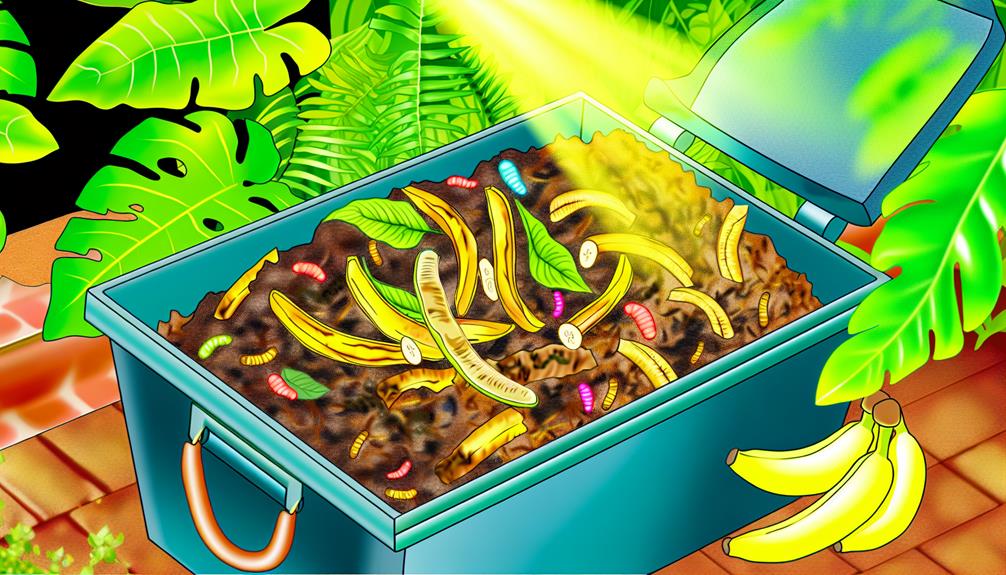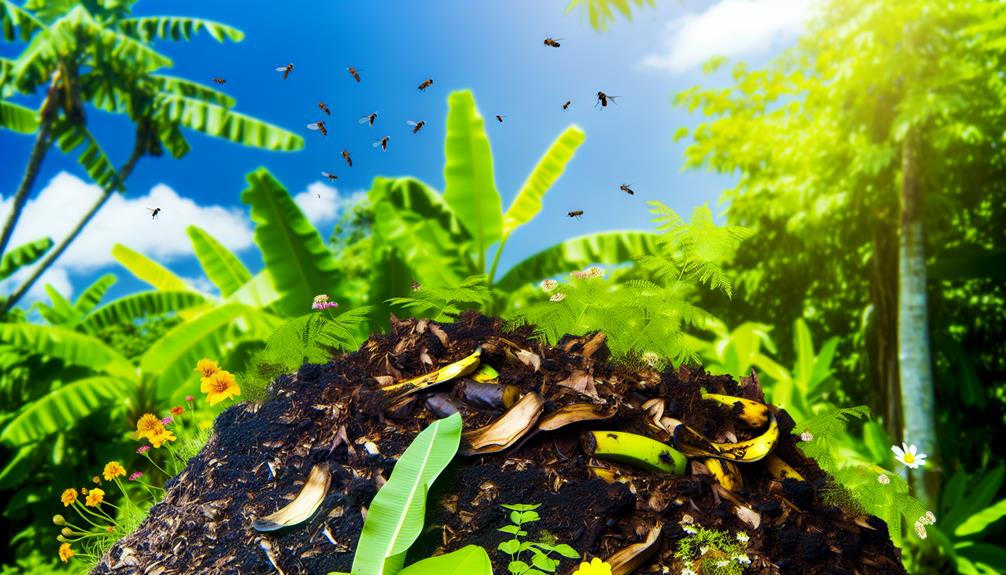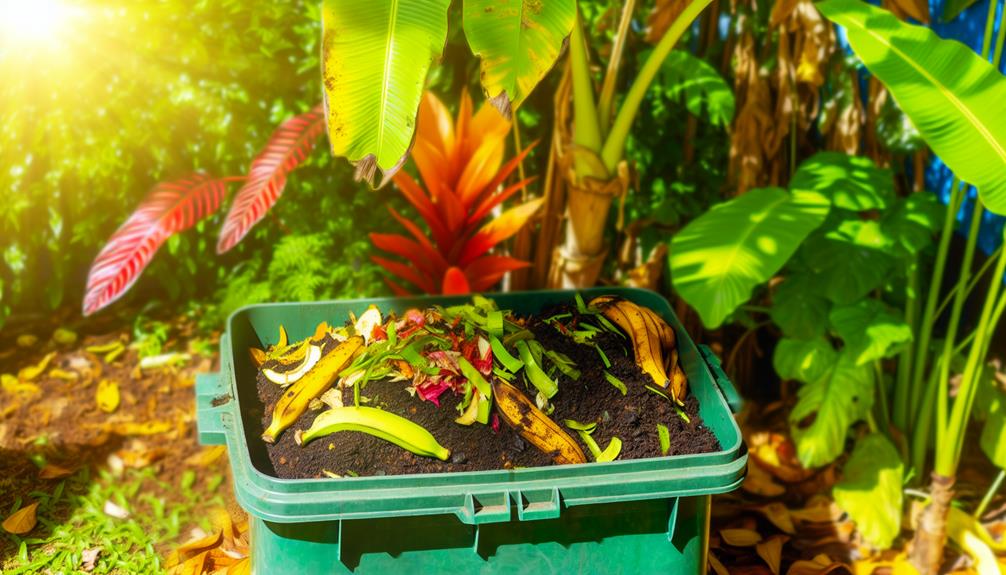

You can compost plantains, and they’ll enrich your pile with valuable nutrients like potassium, magnesium, and vitamins A and C. To speed up decomposition, chop plantains into small pieces and mix well with brown materials like dried leaves. Be mindful of moisture; too many plantains can make your compost wet and smelly.
Turn the compost regularly to maintain aeration and prevent odors. Properly balancing green and brown materials will keep the compost healthy. If you follow these steps, you’ll have nutrient-rich compost that benefits your soil’s structure and fertility. Continue for more detailed tips on optimizing your composting process.
Plantains, rich in nutrients and organic matter, can greatly enhance your compost’s quality. When you’re diving into composting basics, it’s important to understand the role different ingredients play.
Plantains, common in tropical gardening, are an excellent addition to your compost pile. They decompose relatively quickly, providing a rich source of potassium and other essential nutrients.
Start by chopping the plantain peels and any leftover fruit into small pieces. This helps them break down faster and integrate more easily with other compost materials. Remember to mix them well with your browns, like dried leaves and paper, to maintain a balanced compost heap.
Too much green material, such as plantains, can make your compost too wet and smelly.
In tropical gardening, you might find yourself with an abundance of plantain waste. Don’t let it go to waste! Instead, use it to enrich your compost. Keep an eye on the moisture level and turn the pile regularly to ensure proper aeration.
Rich in essential nutrients, plantains offer a powerful boost to your compost’s nutritional profile. Beyond their culinary uses, plantains are packed with an array of vitamins and minerals that can greatly enhance the quality of your compost. Their micronutrient content includes essential elements like potassium, magnesium, and vitamins A and C, which are beneficial for soil health.
Here’s a quick look at the nutritional composition of plantains:
| Nutrient | Quantity per 100g |
|---|---|
| Potassium | 499 mg |
| Magnesium | 37 mg |
| Vitamin A | 1127 IU |
| Vitamin C | 18.4 mg |
Incorporating plantains into your compost doesn’t just recycle waste; it enriches the soil with these dietary benefits, promoting robust plant growth. Potassium, for instance, aids in water regulation and disease resistance in plants, while magnesium is essential for photosynthesis. Vitamin A and C play important roles in plant metabolism and defense mechanisms.
Also Read: Can You Compost Carrot Peel?
By composting plantains, you’ll harness their rich nutritional profile to create a more fertile and resilient soil for your garden. This practice is a fantastic way to improve soil enrichment and contribute to waste reduction in your community.

Nutrient-Rich Compost: Plantains are packed with potassium, phosphorus, and calcium. When you compost them, these nutrients become available to your plants, promoting healthier and stronger growth.
Improved Soil Structure: Composting plantains helps improve the soil’s texture, making it easier for roots to penetrate and access water. This leads to more robust and resilient plants.
Waste Reduction: By composting plantains, you’re diverting organic waste from landfills. This simple action reduces methane emissions and contributes to a more sustainable environment.
Enhanced Microbial Activity: Plantain compost boosts the activity of beneficial microbes in the soil. These microbes play an essential role in breaking down organic matter, making nutrients more accessible to plants.
When composting plantains, you’ll need to monitor for potential issues to guarantee that your compost remains healthy and effective. One major concern is anaerobic decomposition. Plantains have high moisture content, which can lead to a lack of oxygen in your compost pile. When oxygen is scarce, anaerobic decomposition occurs, producing foul smells and slowing down the composting process.
To prevent this, regularly turn your compost pile to allow proper aeration. This ensures that oxygen circulates, helping to maintain a balanced compost environment.
Another issue to watch for is pest attraction. Plantains, like other fruit scraps, can attract pests such as rodents, flies, and raccoons. To minimize this risk, bury plantain scraps deep within your compost pile. This makes it less likely for pests to detect and access the plantains.
Additionally, avoid adding large amounts of plantains at once. Instead, mix them with other compost materials like leaves, straw, or cardboard to create a balanced mix.
Also Read: Can You Compost Cantaloupe?
First, remove the plantain peels to speed up the composting process.
Then, chop the plantains into smaller pieces to increase surface area and promote quicker decomposition.
To prepare plantains for composting, start by peeling off their thick, fibrous skins. This step is important to make sure that your compost pile breaks down efficiently and benefits from the nutrients found in plantains. Before you begin peeling, rinse the plantains thoroughly to remove pesticides and avoid contamination of your compost pile.
Follow these steps to peel plantains effectively:
Check the peeled plantains into small, manageable pieces to expedite the composting process. By doing so, you increase the surface area, allowing microorganisms to break down the plantains faster. Aim for a chop size of about one to two inches. This size is ideal for maintaining a balanced decomposition rate.
To achieve the right chop size, use appropriate cutting tools. A sharp knife or kitchen shears work best. If you want to involve the whole family, a sturdy cutting board can make the task safer and more enjoyable. Here’s a quick guide to the tools and tips for chopping plantains:
| Tool | Tip |
|---|---|
| Sharp Knife | Make sure it’s well-maintained for precision cuts. |
| Kitchen Shears | Great for smaller pieces and added control. |
| Cutting Board | Use a stable one to avoid accidents. |
| Chef’s Knife | Ideal for larger batches; speeds up the process. |
| Safety Gloves | Protects your hands from accidental cuts. |
Regularly mix the chopped plantains with green compost materials to create a balanced compost pile. This combination guarantees you have the right mix of nitrogen and carbon, which is essential for effective decomposition.
As you know, plantains are a tropical fruit, and their decomposition can be accelerated when mixed with green compost items.
Here’s a simple guide to help you mix effectively:
Achieving the right balance in your compost pile guarantees it breaks down efficiently and produces rich, fertile soil. To create this balance, focus on the ideal proportions of green and brown materials.
Greens, like plantains, add nitrogen, while browns, such as dry leaves or cardboard, provide carbon. Aim for a ratio of roughly three parts brown to one part green. This combination ensures your compost pile has the necessary nutrients to decompose effectively.
Proper compost aeration is also essential. Without enough oxygen, your pile can become anaerobic, leading to unpleasant odors and slower decomposition. To maintain good aeration, turn your compost regularly, ideally every one to two weeks. This process introduces air, which helps the microorganisms break down the materials more efficiently.
Additionally, pay attention to moisture levels. Your compost should be as damp as a wrung-out sponge. If it’s too dry, decomposition slows down. If it’s too wet, it can become compacted and smelly. Adjust moisture by adding water or dry materials as needed.
Also Read: Can You Compost Cake?
To guarantee your plantain composting efforts are successful, begin by properly shredding the plantains to speed up decomposition.

You’ll also need to balance green and brown materials to maintain a healthy compost environment.
Lastly, consistently check and adjust the moisture levels to keep the compost active and efficient.
When you’re ready to compost plantains, start by shredding them into small, manageable pieces to accelerate the decomposition process. Proper shredding techniques guarantee that your plantains break down more quickly and integrate smoothly into your compost pile. Using the right compost tools can make this task much easier.
Here’s a step-by-step guide:
Balancing green and brown materials is essential for creating healthy, efficient compost. Green materials, like plantains, provide nitrogen, while brown materials, such as dried leaves, offer carbon. Together, they create a balanced compost pile that decomposes efficiently.
To help you get started, here’s a simple table showing examples of green and brown materials:
| Green Materials | Brown Materials |
|---|---|
| Fresh plantain peels | Dried leaves |
| Vegetable scraps | Straw |
| Coffee grounds | Shredded paper |
| Grass clippings | Cardboard pieces |
| Fruit scraps | Wood chips |
When you’re adding these materials to your compost, aim for a ratio of about 2 parts brown to 1 part green. This balance ensures that microorganisms can break down the materials effectively.
Don’t forget about compost aeration. Turn your compost pile regularly to introduce oxygen, which is important for the decomposition process. Different composting methods, like using a compost tumbler or a simple pile, can also affect how well your compost aerates. Regular turning not only speeds up decomposition but also helps prevent any unpleasant odors.
Maintaining ideal moisture levels in your compost is essential for efficient decomposition and a healthy pile. Too much or too little water can disrupt the composting process.
so let’s explore some effective moisture control and watering techniques.
Yes, you can compost plantain peels and skins! They add great nutrient content to your compost, enriching the soil. You’ll enjoy the compost benefits and feel part of a community dedicated to sustainable living.
Plantains decompose in compost in about 3-6 months. Decomposition factors like temperature and moisture impact this process. As they break down, they contribute to nutrient breakdown, enriching your compost and creating a sense of community sustainability.
You might notice fruit flies and banana weevils attracted to your compost when you include plantains. Keep your compost balanced and covered to minimize these pests, helping you maintain a healthy and welcoming composting community.
Yes, you should chop plantains before adding them to compost. Chopping benefits the decomposition process by increasing surface area, which helps microbes break them down faster, enhancing the nutrient content and making your compost more effective.
Yes, plantains can impact the smell of your compost pile. Maintain proper moisture levels and promote aerobic bacteria by turning the pile regularly. This community-friendly practice keeps odors at bay and your compost healthy.
To conclude, composting plantains is both feasible and beneficial for your garden. Make sure you chop them into smaller pieces to speed up decomposition.
Balance them with carbon-rich materials like leaves or paper. Monitor moisture levels and turn the pile regularly.
By following these steps, you’ll create nutrient-rich compost that enhances soil health. Remember, a balanced compost pile is key to successful composting.
Happy composting!
